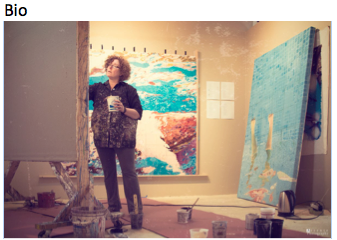Moni Ritchie Hadley
|
I was much further out than you thought, oil on canvas, 42 x 53” Kate Vrijmoet By Kate Vrijmoet When my son was in high school, a friend of mine dropped off the map. I used to see her all the time at school during pick up, at games, and school events. I didn’t see her kid around much anymore either. At first I felt snubbed, when I did see her she was distant. Then one day, a couple of years later, I ran into her and cornered her in a friendly conversation - she burst into tears and told me her son was having some difficulties but didn’t go any further than that. She didn’t need to. I knew what was going on - not because of gossip, but because I had been through it too. What was making her so fragile was that unspeakable thing—the thing that no one EVER talks about? And really, come on, who WANTS to talk about it? I believe 90% of you reading this will make a mental note, “not my problem” and click on next link that’s vying for your attention. According to the CDC,1 Suicide is the second leading cause of death for youth (accidents are the first). So, maybe its time to talk about it, even if it’s uncomfortable to do so. Not my problem. That’s what we all think, especially when our kids are little. In fact, Soooo “not my problem” that it’s not on our radar at all. We’re worried about skinned knees, homework assignments, screen time, play dates, sleep, hygiene, or maybe just hygiene when they’re teens. So, here’s what I want to say to my friend: I see you. I see your pain and I know it. I know it because I have been in your shoes. You are not alone. I couldn’t talk about my son, now all grown up, without the floodgates opening for at least a decade. You never dream about your kid growing up and developing mental illness. You don’t plan for it. Most of us never even consider the possibility. The Risk When a daughter tries suicide and the chimney falls down like a drunk and the dog chews her tail off and the kitchen blows up its shiny kettle and the vacuum cleaner swallows its bag and the toilet washes itself in tears and the bathroom scales weigh in the ghost of the grandmother and the windows, those sky pieces, ride out like boats and the grass rolls down the driveway and the mother lies down on her marriage bed and eats up her heart like two eggs. Written by Anne Sexton (1928-1974) And the vacuum cleaner swallows its bag, oil on canvas, 72 x 84” Kate Vrijmoet A question I often ask is: How can we parents help build community with each other to support our children through their adolescent years? Why is this important? It’s important so we can have the grace to walk into the awkward space of telling an uncomfortable truth for the greater good of the child, family, and community. If my daughter’s friend is in crisis, calling my children and threatening suicide (yes, this has happened), and I don’t teach my children to speak up and I don’t speak up myself, I’m not only harming that other child and their family, I’m harming my own children and our family. The idea that it’s “none of my business” is absurd to me. Of course it is my business. Everything about the life of my child is my business, even if I give them the illusion of privacy. Today my teenage girls have many friends who have anxiety, depression, anorexia, bi-polar and more. They talk opening about these issues. This generation is also robustly exploring gender identity, pronoun use, and non-binary gender.2 A couple of years ago, my girls’ friend Molina decided to become Mel. Then they changed their pronouns to non-binary pronouns, they/them. My girls supported their friend and celebrated their differences, as did their entire friend cohort. Then Mel’s behavior became erratic. Mel would call my youngest daughter and spend hours on the phone, after which my daughter would come to me crying. She was scared Mel was going to hurt themselves. I called Mel’s mom, who needed no prompting to confide that Mel was having mental health issues. Mel was holding the family hostage with frequent threats of suicide. Their mom told me that she and her husband’s marriage was also in crisis, yet they were working together to find help for Mel. We came up with a “friend plan” for interactions between our kids. The plan was for me to explain to my teens that Mel was struggling, we knew they loved them and were concerned for them. We reassured my children that Mel’s parents were aware of what was going on and were actively seeking help for Mel with therapeutic solutions currently in place. My husband and I worked with our daughters to talk them through how to handle themselves during these phone calls. Together we decided the following:
In the meantime, we developed a relationship with Mel’s parents. The adults all agreed to continue to tell the uncomfortable truth. Feeling safer in her community, Mel’s mom reached out to all the parents in Mel’s friend group, to tell them about Mel’s mental health crisis and what she and her husband were doing to help Mel. She invited a group conversation about it. I thought that was a great step forward in resisting shame and stigma and enlisting her community for the greater good of all the kids. What she hadn’t realized was that among that set of parents were two families who had worked behind her back to undermine her. They had reacted to Mel’s tales of abuse by developing a plan together to help Mel run away from home, and to hide them. What?!?! Yes, the parents were colluding to help Mel run away from home. Even though they probably thought they were doing the right thing and were trying to help. This was not the way to help Mel, her family, or their own children. And its charms have a punch. And its hunches have arms. Oil on canvas, 44 x 108” Kate Vrijmoet It’s taken two years, but Mel’s mom contacted me recently to tell me that they finally had a diagnosis. It’s normal for it to take a long time to diagnose adolescents, especially when they’re in crisis. The crisis behavior can mask the underlying problem. And because they’re still developing, it can be difficult to pinpoint the issue and to get the treatment right. Things are much better for Mel’s family and for Mel and slowly they’re making progress. Like physical illness, mental illness responds well to early intervention. Learn to recognize the signs of depression, stress, and anxiety. Does your kid have connection in his/her life? Are they sleeping enough? Are they eating right? How’s their hygiene? Do they get regular cardio vascular exercise? Do they have good social media and electronic device boundaries? Some kids are just wired with a predisposition to mental health issues. Maybe you have family members prone to this…that’s an indicator that your child may be susceptible too. Maybe you have a child that is exceptionally or profoundly gifted, that population has much higher rates of depression and anxiety.3, 4, 5 Maybe they’re addicted to social media. Dr. Cuddy’s (power pose) new research delves into the chemical changes in our bodies when we’re hunched over hand-held devices and it’s alarming. Cortisol rises, that’s the stress hormone. No wonder our kids have ever increasing rates of anxiety.6, 7 After my son’s suicide attempt, it took me a while to find him the help he needed. The reason it took so long is because mental illness stigma is so great. There were no resources the school would offer us. It was as if no other kid had ever been through what our son was experiencing. We didn’t know any other families to talk to. People just don’t advertise when their kid is in crisis, both because of stigma and because you’re too busy trying to keep them alive long enough to usher them out of crisis. And many mental health professionals at the time had an antiquated idea that if a kid is in crisis, then the mother is at fault. That concept is a holdover from the early versions of the DSM 8 which blamed most mental health issues on mothers. It’s an idea that’s slowly working its way out of the mental health care system. Stigma, it’s a strange, self-perpetuating thing in our society. Stigma is a way of othering people. Stigma says: don’t think about this, don’t talk about this, this is shameful, unacceptable, embarrassing. Stay silent. No one needs to know. The effect of course, only deepens the shame, extends the impact, and makes resource discovery extremely difficult. Now that I’m talking about mental illness after a decade of silent suffering, I can’t seem to shut up. In 2013 I started an exhibit with two other artists who also have children with mental illness. Our idea is simple, to end stigma, end silence. Our exhibit is called: The Incredible Intensity of Just Being Human.9 My own son is thirty now. He has more good days than bad days. In the years since graduating from his therapeutic boarding school, he has made three more attempts on his life. The good news is that in another five years he will be past the statistic for men and suicide and his chances of survival take a giant leap forward. That means I might be able to stop waiting for that dreaded phone call every time my phone rings. What more, the last time he felt he was in danger, he took himself to get help, and has continued with the plan he and his doctor have devised for him to great success. I’m so proud of him. References:
NAMI: National Alliance on Mental Illness offers resources for parents and patients alike. There are chapters all over the country, in every major city. http://www.nami.org/ Teen Line: A Los Angeles teen crisis hotline founded by Dr. Elaine Leader. https://teenlineonline.org/ Profiles of Hope (LA) http://profilesofhopela.com/resources/ LA COE Prevent Suicide http://preventsuicide.lacoe.edu/ Teen Feed http://www.teenfeed.org/ Friends of Youth (PNW) http://www.friendsofyouth.org/ Youthcare (Seattle) http://www.youthcare.org/ PSKS (Seattle) http://www.psks.org/ Seattle painter, curator and social artist Kate Vrijmoet lives and works in Seattle, WA. She received her MFA from Syracuse University. Her paintings and installations focus on the human body and the human condition, and on issues of consciousness, privilege, scale and access. Working both in paint and social sculpture, she uses the tools of classical painting to create high-impact experiences for her audience—experiences that have a lot in common with theatre. She is known best for both my water and my accident paintings.
The social sculpture she creates is a real-time exchange between people in order to heighten consciousness with themselves and others. “My role is to facilitate deep connections among us through art. Through my work I am engaged in a highly energetic conversation with my audience and reflect that in the way I capture my subjects, by deconstructing the figure, and finding rhythm in form.” Vrijmoet was one of 16 American artists participating in the 2012 5th Beijing International Biennial. Vrijmoet has exhibited in shows juried by curators of the MOMA (Paulina Pobocha), the Met (Anne Strauss), the Guggenheim (Nat Trotman), and the Brooklyn Museum of Art (Charlotta Kotik). She received 3rd Prize in 2010 Ecuador Biennial. Her work has been published in the 2014 book Ufora, New American Paintings, The Seattle Times, Catapult Magazine. She is published in numerous catalogs including her CoCA Seattle solo exhibit catalog: Kate Vrijmoet: Essential Gestures, Uforafest, The Richard Siken Project, CoCA Annual 2014, and more. She has received numerous Grants. Vrijmoet is the curator of The Incredible Intensity of Just Being Human, an art & social change exhibit examining the stigma and silence surrounding mental illness. www.katevrijmoet.com
1 Comment
|




 RSS Feed
RSS Feed
